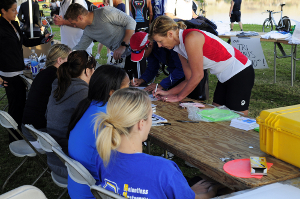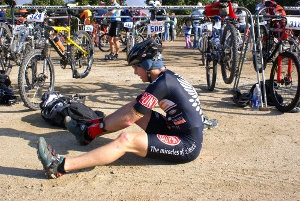Triathlon Tips Guide
As with any sport, knowing valuable tips and tricks of the game can often make the difference between a victory and a loss. Some tricks are executed while training months before the event, while others are mental tactics saved for the final 200 yards of the home stretch.
Triathletes share in the knowledge of hundreds of valuable tips – all of which can better their performance come race-day. Either way, all of these tips are essential to a successful race event; an enjoyable race and a fast time. Here are 10 key triathlon tips that are sure to improve your performance:
1) Get Extra Sleep
Many triathletes get the "butterflies" the night before a race, and the resulting excitement/nervous energy can produce a near-sleepless night. A sleepless night, in turn, can result in a decreased energy level for the triathlete, causing a sub-par performance. To combat a sleepless night before the race, try going to bed early two nights before the event. If possible, sleep in the following morning. The body is capable of saving some of these extra hours of sleep as reserve energy, which can be used on race-day.
2) Arrive Informed & Prepared
 This tip is similar to the two-bag precautionary measure listed below: Always come to the race prepared. More so than just bringing the right equipment is the importance of researching the event beforehand:
This tip is similar to the two-bag precautionary measure listed below: Always come to the race prepared. More so than just bringing the right equipment is the importance of researching the event beforehand:
- Study the course map and schedule: Almost all triathlons provide a course/event description and map before the race,) and even read forums about the race over past years. A lot of insight, which may be course-specific, can be gathered with a little research.
- Have post-race gear handy: When traveling to the event, be sure to bring along all non-race-related equipment, such as a map or GPS, the USAT membership card, and a pair of clothes to change into after the race.
Race day can be nerve-racking, so it is best to complete all research and pre-race preparation a day or two before the event.
3) Arrive Early
A single triathlon can include over 1,000 competitors. As a result, these events can become extremely crowded. Just as quickly as parking and transition-area space fills up, pre-race supplements and other amenities disappear quickly. Lines for race-day check-in and/or the restroom back up with people and can quickly hinder your pre-race preparations. Arriving early eliminates all of these concerns. Always allow ample time for finding parking, checking in, setting up transition, stretching, warming up, and even taking photos with friends.
4) Bring Two Bags
There are numerous reasons to bring two bags to a triathlon. The primary reason revolves around the interest of the two-transition process:
- Most triathlons will provide race information through a web page or a flyer, noting race location, event times, transition logistics, etc.
- Place a smaller, foldable bag (large enough to fit shoes and a towel when opened,) inside your primary transition bag to save space. When needed, like if there are two transition areas, simply remove the Transition 2 items and place them inside the smaller bag. Leave them where instructed and proceed onto the Transition 1 area.
It won't make a huge difference, but having two bags available will help streamline your transitioning process.
5) Swim Fast
Most triathletes are familiar with the quote: “You can’t win a race in the swim, but you sure can lose it.” This bit of wisdom is regularly passed from triathlete to triathlete because of its value to race-day performance. A strong swim performance will only win a triathlon event if it is followed by a strong bike and strong run. That being said, a weak swim performance can easily hinder your overall performance and/or race time.
6) Remember that Transitions are Timed
 Many novice triathletes consider the transition area to be a place of shelter from the difficult race in which they are participating. They relax while changing gear for the next leg of the event, and forget that the clock is still running. In reality, transition areas should be battled through with just as much effort, if not more, than the actual legs of the race. It is better to power through a fast transition and begin the following leg of the race a little easy, than it is to relax during transition and take off on the following leg with a sprint.
Many novice triathletes consider the transition area to be a place of shelter from the difficult race in which they are participating. They relax while changing gear for the next leg of the event, and forget that the clock is still running. In reality, transition areas should be battled through with just as much effort, if not more, than the actual legs of the race. It is better to power through a fast transition and begin the following leg of the race a little easy, than it is to relax during transition and take off on the following leg with a sprint.
7) Never Break in Equipment on Race Day
The days leading up to an upcoming triathlon are exciting to say the least. After months of hard training, it is time to finally put your abilities to the test. A common worry for many triathletes is that they will be ill-prepared or ill-equipped, especially when it comes to their gear. As a result, they frantically purchase a new pair of equipment (shoes, aero bars, etc.), thinking it will provide them with the edge they need to succeed.
However, the triathlete’s lack of use with that new piece of equipment, along with an insufficient ‘break-in’ period, can be detrimental to their race-day performance. Waiting to test out an unknown piece of equipment during the race is unwise; new shoes could often result in blisters, and new biking equipment can fail on its first use (especially if it’s installed incorrectly). It’s best to race with the equipment that you are comfortable with, and save the test runs for training.
8) Hydrate Yourself like a Plant
While training or racing, hydration should occur frequently with small sips of the triathlete’s beverage of choice:
- Similar to watering a plant, consuming too much water too quickly will result in a waste of fluid.
- Small, intermittent sips of water will result in superior absorption.
It can become extremely uncomfortable and/or detrimental to a triathlete’s time if he has the urge to use the bathroom throughout the race. Efficient hydration absorption helps reduce this risk.
9) Cycle with Sunglasses
Far more than a typical fashion statement, it is important to wear cycling glasses for a variety of reasons. Two of the reasons deal with glare reduction and eye protection:
- Squinting, as a result of a strong glare, can become uncomfortable over time; cycling glasses will alleviate this burden.
- Additionally, it is inevitable that insects will fly into the triathlete, especially while cycling at a high speed. Catching an insect in the eye will not only hurt, it will increase the possibility of an accident, as the rider typically closes the struck eye as an initial reaction.
Regardless of the cause, riding with restricted vision can hinder peripheral vision, as well as limit depth perception. This can be extremely dangerous while traveling at high speeds or in a group of other riders.
10) Enjoy the Experience
Sure, a triathlon is technically a race against the other competitors, but ultimately it’s each participant against the course itself. Removing a triathlete from his standard training comfort zone and placing him in a foreign, highly competitive environment can be daunting to say the least. The key is to relax, and focus on enjoying the race!
